 |
| Young people in MoCo choose to be near jobs, hangouts and transit. Photo by katmere on Flickr. |
According to the 2010 Census, Montgomery County has about 186,000 residents between the ages of 20 and 34, making up about 19% of the county's population. In a recent Washington Post article about the county's Night Time Economy Initiative, reporter Bill Turque notes that young adults make up a lower share of Montgomery County's population than other places in Greater Washington.
Why is that? Trends show that Millennials want an urban lifestyle, but are often stymied by limited funds and a dearth of affordable housing. As a predominantly suburban, affluent county, Montgomery doesn't seem like the kind of place where young adults would want to live.
However, if you look at individual neighborhoods, you'll find substantial concentrations of Millennials, suggesting a way forward for Montgomery County as it seeks to draw more of them.
Millennials flock to areas near transit, jobs, affordable housing
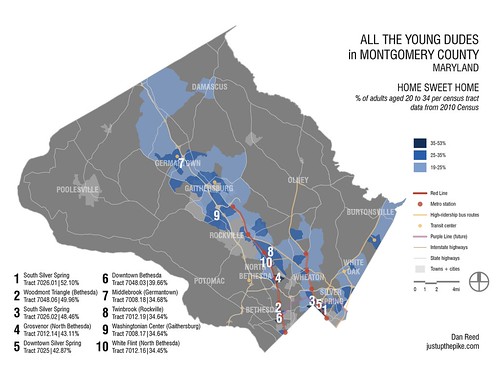 |
Where Millennials live in Montgomery County. Click on the image for a bigger version, or click here to see it without the rankings.
|
Here's a map of Census tracts where the percentage of 20-to-34 year old residents is higher than the county's 19% average in the 2010 Census. The county's largest concentrations of Millennials are along the Red Line in places like White Flint, downtown Bethesda and downtown Silver Spring, where young adults are a slim majority. Notably, these are also the places where walking, biking and taking transit to work are most common.
Young adults also seem to gravitate towards shopping and entertainment districts like the Washingtonian Center in Gaithersburg. Even though it's not near a Metro station or major bus route, Washingtonian Center is a pretty walkable area where one can shop or grab dinner without a car.
We can also conclude that many Millennials are trying to live as close as possible to their jobs. Here's a map of where people under 29 work in Montgomery County:
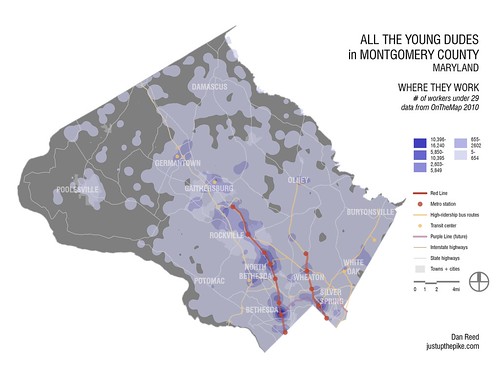 |
Where Millennials work in Montgomery County.
|
Compare it to the first map and you can see that clusters of young people coincide with the county's biggest job centers, White Flint, Bethesda and Silver Spring. Yet there are also large concentrations of Millennials in places with fewer jobs, like Briggs Chaney in East County and Germantown in the Upcounty.
Not surprisingly, these communities are also more affordable. According to the 2006-2011 American Community Survey, the median monthly rent is $1565 in Census tract 7048.06 in Bethesda's Woodmont Triangle, compared to $1344 in Census tract 7008.18 in the Middlebrook section of Germantown.
Both of these neighborhoods have some of the county's largest concentrations of Millennials, suggesting that there may be more to it than affordability. If we take a closer look at different segments of the county's young adults, we can get a better understanding of why they live where they do.
Educated and single Millennials move closer in
Here's a map of 18-to-34-year olds with at least an associate's degree:
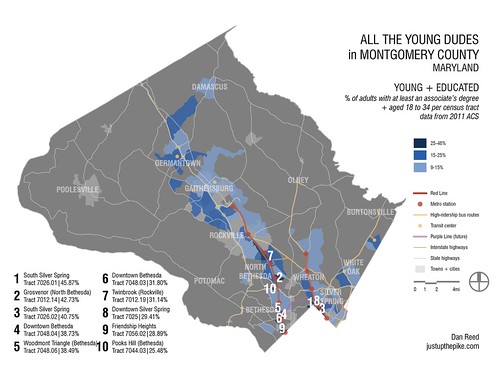 |
Where college-educated Millennials live in Montgomery County. Click on the image for a bigger version, or click here to see it without the rankings.
|
The general distribution of young people is the same, but there's a slight shift towards the Downcounty. College-educated people tend to have higher incomes, which might explain why there are more of them in expensive areas like Bethesda and Friendship Heights.
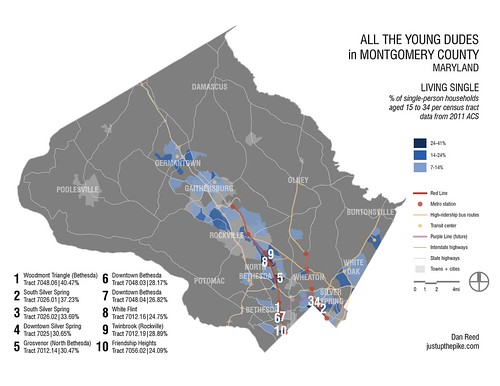 |
Where single Millennials live in Montgomery County. Click on the image for a bigger version, or click here to see it without the rankings.
|
However, the county's single Millennials have decidedly chosen to live closer in, settling in and around downtown Silver Spring, downtown Bethesda, Friendship Heights and White Flint. These neighborhoods have almost everything that a young single person would want: they're close to Metro, major employers and the District, they contain a fair number of bars and restaurants, and they have a variety of housing options. Silver Spring in particular has a number of group houses.
Millennials with families move further out
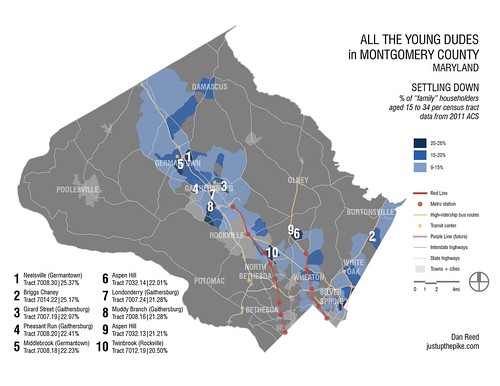 |
|
Where young families live in Montgomery County. Click on the image for a bigger version, or click here to see it without the rankings. |
While singles are flocking to closer-in neighborhoods, Montgomery's young families, defined here as households led by individuals under 34 and related by marriage, blood or adoption, are moving further out. All ten of the county's largest concentrations of young families are well outside the Beltway, particularly in Gaithersburg and Germantown. Just one is near a Metro station, Twinbrook.
This fits the long-held stereotype that once you get married and have kids, you move to the suburbs in search of larger, more affordable housing. Not only is it cheaper to rent in the Upcounty, it's cheaper to buy: the median home value in Middlebrook is just $294,000, compared to $516,800 in the Woodmont Triangle.
Yet families who choose to move farther out will pay considerably more for transportation than they would elsewhere. That might explain why young families appear to have settled in neighborhoods like Fallsgrove in Rockville, which were designed to encourage walking and biking, near shopping areas like Washingtonian Center or employment areas like the Shady Grove Life Sciences Center.
Meanwhile, young families still make up one-tenth of all households in downtown Bethesda and downtown Silver Spring, suggesting that some are interested in an urban lifestyle. This isn't a new trend: I grew up in an high-rise apartment building in downtown Silver Spring in the 1990's, and there were plenty of kids around. Of course, my mother chose to live there because it was "affordable and quiet," which I'm not sure characterizes the area today.
What does this mean?
These maps have implications not just for Montgomery County, but the whole region. They show that the District and Arlington aren't the only places that can attract Millennials, so long as they can be near neighborhoods near transit, shopping and jobs. While many young families are choosing to live further out, they're still seeking a semi-urban experience.
They also show that one of Montgomery's greatest strengths remains its diversity of neighborhoods, allowing it to attract both singles and families. However, two distinct challenges lie ahead. One is to preserve a supply of affordably-priced housing in the county's urban areas, both established places like Bethesda or emerging ones like White Flint. The other is to create more walkable neighborhoods and improve access to jobs, shopping and transit in the Upcounty and East County, where young families continue to settle.
Of course, Millennials aren't the only ones who want an urban or semi-urban lifestyle. But if Montgomery County wants to attract a new generation of residents, it needs to start listening to young adults. Without us, the county doesn't have much of a future.
Crossposted from the Friends of White Flint.

1 comment:
Affordable housing is a major issue in Silver Spring. The rebirth of downtown Silver Spring has been a wonderful development for residents looking for new dining, retail and entertainment options. Getting the Discovery Media empire to relocate to DTSS was a real coup.
I live within walking distance of the Metro station, restaurants, Giant, Whole Foods, Einstein Bagels, AFI theater, the Fillmore you name it. I love the lifestyle. I love walking but I hate driving.
Unfortunately, the landlords and real estate developers are remolding downtown Silver Spring into a "gated community" where only the professional near-affluent class can afford DTSS. The rents are outrageous for new apartment complexes where one-bedroom units start at $2,000 (not including utilities) and UP.
Older apartment complexes such as The Blairs and Summit Hills are raising rents between 5-10 percent and in some cases more on the current residents.
In other words, I might have to leave Silver Spring and this is not by choice.
Living within close distance of grocery stores, pharmacies, and public transportation should not just be a privilege for the higher-income professional class. Guess what? Poor people, middle-class people, working-class people like the urban, walking lifestyle too. But the landlords and developers only care about the return on their investment. They earn more bang for their buck by attracting a certain socio-economic demographic.
So poorer individuals and families have to move farther away where they are REQUIRED to use a vehicle for commuting or for personal errands. The commuting costs in terms of money, time and stress increase considerably. Meanwhile, the hot-shot yuppies can stroll a couple of blocks to the Silver Spring Metro and it's an easy-peasy commute into the city. But as an aside, you would be surprised how many luxury apartment renters in Silver Spring own their own vehicle and commute by car to Virginia, downtown DC or Bethesda. They don't even bother with WMATA transportation but the landlords & developers treat public transportation access as a super-duper privilege. Funny, isn't it?
As you move farther away from the urban core of Silver Spring, you are more isolated from everyday activity like going to playgrounds, walking to grocery store, hitting the running/bike trails etc. Numerous studies have shown that individuals who rely on car transportation in suburban communities tend to have higher obesity rates. Gee, wonder why. Some suburban communities have inadequate sidewalk development, which makes it unsafe for jogging or cycling. You also have major intersections which are death traps for pedestrians.
Elected officials have no real solution to the problem. Why would they bother? More affluent home buyers and renters are a net-gain revenue for the city or county. Net-gain for property taxes. Net-gain for income taxes. Big boost in local business sales, which means more taxes for the local government. Local governments will never take a more active role in subsidizing housing for modest income families and workers. I can only envision policy action deriving from Annapolis or at the federal level.
That's my two pennies.
Post a Comment